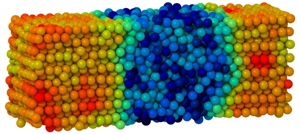May 21 2014
Computer simulations play an increasingly important role in the description and development of new materials. Yet, despite major advances in computer technology, the simulations in statistical physics are typically restricted to systems of up to a few 100,000 particles, which is many times smaller than the actual material quantities used in typical experiments.
Researchers therefore use so-called finite-size corrections in order to adjust the results obtained for comparatively small simulation systems to the macroscopic scale. A team of researchers from Johannes Gutenberg University Mainz (JGU) has now succeeded in better understanding how this technique works when it is used to assess interfacial tension, thus enabling more accurate predictions.
 At coexistence, the crystal (red) and the fluid (blue) are separated by interfaces. The simulation box shown here contains 3,660 hard sphere particles. Using periodic boundary conditions and finite-size scaling (systematic variation of the box size), computer simulations allow high precision measurements of the interfacial tension. Ill.: Fabian Schmitz
At coexistence, the crystal (red) and the fluid (blue) are separated by interfaces. The simulation box shown here contains 3,660 hard sphere particles. Using periodic boundary conditions and finite-size scaling (systematic variation of the box size), computer simulations allow high precision measurements of the interfacial tension. Ill.: Fabian Schmitz
The interfacial tension is an important physical quantity of many phenomena, such as the nucleation of water droplets in the atmosphere, the crystallization of proteins from solutions, and the growth and stability of nanocrystals. It occurs at the interface between different phases of a material, i.e., on the transition between solid, liquid, and gaseous phases. However, the interfacial tension is difficult to measure experimentally, and reliable analytical theories about it are also lacking. Thus it is of particular importance to develop computer simulation techniques for this phenomenon.
Using an innovative simulation method, Fabian Schmitz, Dr. Peter Virnau, and Professor Kurt Binder of the Condensed Matter Theory group at JGU's Institute of Physics have now succeeded in gaining a better understanding of the nature of finite-size corrections in the determination of interfacial tension. This work, achieved only after several million CPU hours on the Mainz supercomputer MOGON, will in the future help researchers to analyze interfacial tension with the highest precision by means of simulations. The results were published in the leading journal Physical Review Letters.
High-performance computing becomes increasingly important at Johannes Gutenberg University Mainz. The planned new supercomputer MOGON II is expected to replace the current system in the first quarter of 2016. It is expected that MOGON II will be among the top 100 fastest high-performance computers worldwide.